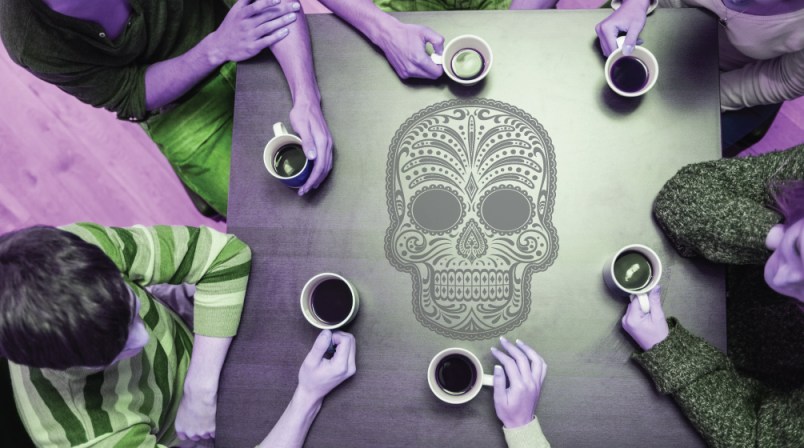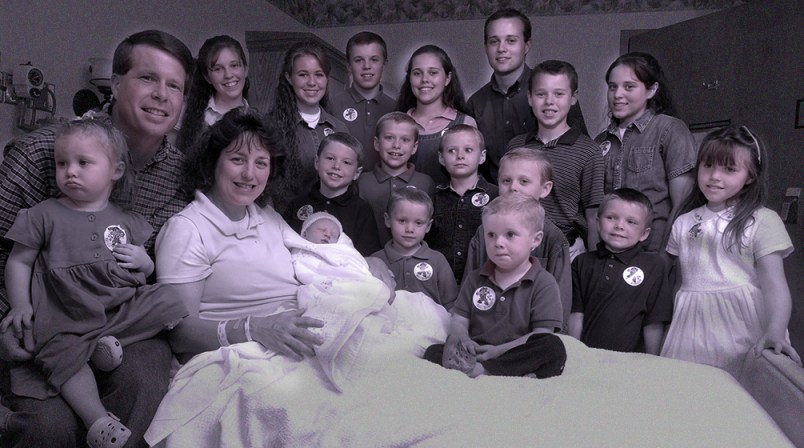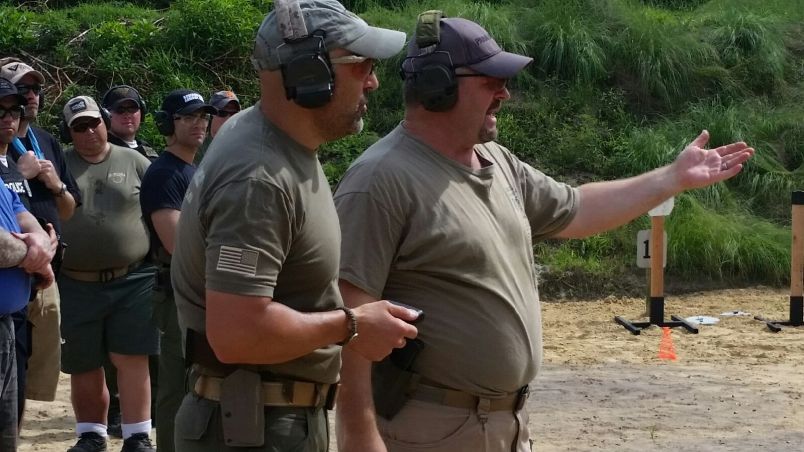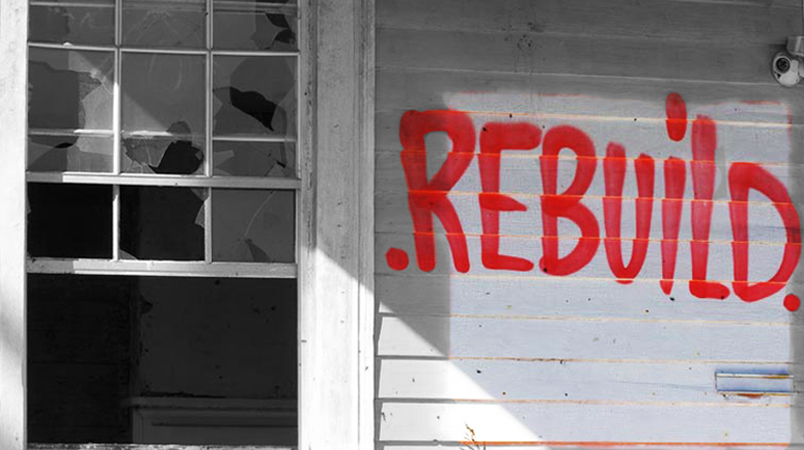I lie on the floor, my eyeballs drying, my mouth agape.
“I just want to talk about death,” I say. “And being dead. And how my body will be splayed out when I die.”
“Stop,” my wife says. “I hate it when you do this shit.”
My wife doesn’t like when I talk about death, mostly because I have never been able to take death seriously. This doesn’t preclude me from constantly bringing up my own death in everyday discussions. Will she find my body? Will she be sad when I’m gone? Will anyone?
This shouldn’t surprise her, that the man she married—a part-time nihilist who still routinely listens to bands with names like Obituary and Carcass at age 31, a man whose version of Disneyland is the Mütter Museum—cannot have an earnest discussion about dying. She, the logical component of our partnership, the one who makes more money and does our taxes and pays our mortgage, could probably handle an adult conversation about resuscitative measures and next of kin, and even grief, if I could manage to be forthright about it. I’m more interested in what my corpse will look like and what song she’ll play to bring the house down at my funeral. I can talk about death—all day long, in fact—but only superficially. We used to talk about my father’s attempted suicide when we first started dating, but somewhere along the way I became jaded. No one close to me has died or tried to die in almost 10 years.
So I set out to finally have an authentic conversation about death. I’d recently learned what a Death Cafe was—gatherings held in events spaces, basements or actual cafes, where one can speak about death in a safe space without religious affiliation, judgment or a strict agenda. It sounds like a God-free support group. With refreshments. I’m sold.
As it happens, there’s a Death Cafe that week an hour from my house in Austin. Perhaps there, in front of strangers, I’d find the courage to open up about the death and suicide anxiety I had been experiencing for years.
Jon Underwood got the idea for the Death Cafe model in 2010. Clear-headed discussion of the great beyond was not a foreign concept to the British Buddhist and former hospice volunteer, so he naturally came across the Cafes Mortels of Swiss philosopher Bernard Crettaz. Though Underwood couldn’t read Crettaz’s French writings on death, he took inspiration in their context.
“I thought, ‘that’s it, that’s it, that’s it,’” Underwood remembers. “Immediately I wanted to do that.”
At this point, there have been Death Cafes set up in 29 countries, and just as the nomadic food trucks in Austin drop anchor on a brick-and-mortar location once they become successful, so will Underwood, with a permanent Death Cafe poised to open in London in the next couple of years.
For now, the Keller-Rihn studio in San Antonio will do. I throw on a black bootleg shirt depicting a logo for the short-lived Swedish black metal band Morbid, and I make an appropriate Spotify playlist. The theme of death is much too broad in music, so I focus on the aspect of death that haunts me the most: suicide. With the Morbid vocalist’s suicide in mind—his nickname was Dead, after all—and fueled by songs like Bowie’s “Quicksand” and “Beyond the Realms of Death” by Judas Priest, I head south from Austin.

The location of the Death Cafe is a caricature of what I’d imagine it to be. Tucked above a coffee shop in San Antonio’s Lone Star Art District, it looks like the living room of a lesbian couple’s Hudson Valley summer home: red, faded oriental rugs, wooden coffee tables with Tibetan-looking etchings, couches drooping sadly from wear.
I introduce myself to two women, Deborah Keller-Rihn and Laurie Dietrich. Keller-Rihn, a lovely and welcoming woman, is not the facilitator of this Death Cafe, merely the owner of the space. Dietrich is an artist and hospice volunteer and the facilitator of AltSA Death Cafe, the sister program to San Antonio Death Cafe geared toward those who identify with an “alternative lifestyle”—gender identification, sexuality, spirituality and so on.
“When you talk about death, religion comes up fast,” Dietrich says. “That’s why we’re making a space where religion isn’t going to immediately make people—or even one person—in the room feel like an outsider.”
Does it get morose? I wanted to know.
“This one could get intense if Petra comes,” Keller-Rihn says, looking down at her knees. “She just lost a son.”
I’m now zeroed in on finding Petra. If she can open up in public on a sunny Saturday in front of mostly unfamiliar faces, so can I.
People begin to shuffle in: a Hispanic man who looks to be in his early 40s, wearing a maroon MIT T-shirt and jean shorts; two local sociology students; matronly artist types; a short white man who isn’t old, but old enough that his glasses can be called spectacles. We sit thigh-to-thigh, our faces inches apart, the space between us filled only by beige treats: individually wrapped peppermint Lifesavers, Mint Milanos, prepackaged sugar cookies with pink, fluffy frosting—the only vibrant color among our snacks.
There’s a young woman, Bianca, who helps with Keller-Rihn’s Mandala Healing Arts project on weekends. She’s wandered into the Death Cafe unaware, having shown up for a volunteer shift at the studio expecting a much different conversation. That doesn’t prevent her from excitedly telling two stories, one about the dead body of a man stuffed in his own car’s trunk for weeks and the other about her best friend’s mother’s suicide. We jump from one man’s guilt over technology and its dissociative nature to the ease of his own will-planning in the span of a few minutes.
“And if you’re childless and single like I am, nobody gives a shit,” Jesse, the man in the maroon shirt, says. “It took me five minutes. Sprinkle some holy water, scatter the ashes, two witnesses, and it’s done.”
We talk about how technology diminishes the need to visit a sick relative in person, how we’re all part of this invisible, intangible network that ultimately doesn’t mean much. The conversations are interesting, but meandering; we don’t get too deep on any one topic, which is a disappointment. And even though I feel like I’m in a safe space, I still can’t muster saying anything personal.
Dietrich, the woman I met on the way in, is my polar opposite—she can speak about death frankly and eloquently. I learn later that she’s also a funhouse mirror image of what could have been the night I almost lost my father: When Dietrich was 27, she received a phone call that her parents had died after the plane they were traveling on smashed into the side of a mountain. She felt all the normal emotions, like sadness and grief, but she also felt relieved, which not everyone around her understood.
“One of the things my brain did immediately after the loss of my parents was also register, ‘OK, that’s done now, that’s something I no longer have to steel myself for or wonder about,” Dietrich tells me a couple of weeks after the Death Cafe. “There’s a relief there.” In this moment, I envied Dietrich.
Dietrich has watched hundreds of people die under hospice care. Though nobody wants to die, she says, the inevitability of death is freeing for both the dying and those they leave behind, much as it was for her and her parents. In some ways, death is a gift.
“This big mystery we spend so much time and energy and resources wondering about, this person now knows,” Dietrich says of a typical hospice patient who has died. “And I still don’t.”

Back at the café in San Antonio, halfway through the session, two women walk back to our corner of the space.
“Oh, hi Petra,” Keller-Rihn says. My ears perk up.
A woman in a red blouse waves without smiling or saying a word. She’s arrived with a graying hippie-looking woman in a tie-dyed shirt and pink Nikes named Lauren, who begins talking immediately and does not stop for 15 solid minutes. Her brother Tony died last year from pancreatic cancer, and it tore her family apart. This is another common theme at the Death Cafe I attend: death taking more than just the dead.
“I feel like I was starting my own death in the face,” Lauren says, staring at the ground. “And I want to live 1,000 years…maybe 1,500.”
Lauren laughs. Suddenly, I notice that Petra’s chair is empty.
Frustrated at my cowardice, and because the one person I wanted to speak to ghosted unexpectedly, I drive back to Austin slowly. “Darklands” by The Jesus and Mary Chain shuffles on, but I shut off the stereo before William Reed starts singing about suicide. I couldn’t talk about the fear of losing my father if his despondency crept back in, but I couldn’t continue to treat death like some meaningless words in a pop song, either.

Crettaz started his proto-Death Cafes because he was looking for an authentic way to talk about death—emotional yet practical, honest yet not sentimental. But why is it catching on now, with death salons in the U.K. going back as far as the 1980s?
Underwood has a theory: baby boomers.
“That generation is getting older and beginning to engage with these issues,” Underwood says. “People are unsatisfied and looking for answers, at least asking questions. That has led people to death.”
But there’s a problem: Death Cafes are pretty white, a fact that irks Underwood. He tells me that there’s a perception that they’re primarily organized and attended by older white women. As the rules are exceedingly lax in what can be called an official Death Cafe, Underwood can’t—nor does he want to—control the goings-on in coffee shops and art spaces around the globe. That’s why the permanent Death Cafe in London is so important to him.
“If this thing gets funded and then it’s just a group of smug white people such as myself … it doesn’t sit right with me,” Underwood says.
The fundraising process, about which he feels optimistic, will commence this spring, ending some time around August. From there comes site selection, electing a management group, and the rest of the minutiae that makes a business official. It will operate like a normal coffee shop would, except the cafe will double as an events space, curated by management and overseen by a board that would put diversity and inclusivity at the forefront.
Death, after all, is the only thing that truly unites every human. But scratch the surface, and the Death Cafes are more about honesty and empathy than anything else. I later track down Petra because I needed to know why she left that day, and her answer was one I hadn’t even considered.
“I couldn’t bear everybody else’s pain because I just knew what the pain was, how it felt,” Petra says, her voice shaking. ”I could just handle mine.”
When Lauren was unraveling her yarn of grief to the group, Petra wasn’t thinking about herself. Yes, she was aware that her 41-year-old son had died just weeks before, but what caused her to flee the room was empathy. She had channeled her friend’s pain, she had allowed herself to experience the grief of another, not just to be kind, but to be open, to be honest. Once I know the backstory, Petra’s early departure from the Death Cafe becomes its most powerful and revealing moment.
Still, Petra has tentative plans to return, to tell her story when she’s ready.
“My heart’s still bleeding. How long does the heart bleed? Probably always,” Petra says. “But right now it’s an open wound. Eventually it’ll heal a little more, and I’ll share my situation.”
I feel the same way. I’m still hurt by something that happened almost eight years ago, and it didn’t even end with a death. One night in April 2007, my mom heard the family dog barking downstairs, alerting her to a gruesome image of her then-husband trying to hang himself. But what if the dog was asleep? What if my mother had never woken up? I don’t have to consider this reality. In keeping death a cursory topic in my house, I’m able to dip my toes in without much risk. The Death Cafe was my chance to dive in headfirst. I didn’t take it, but now that I’ve ripped the bandage off, I can’t turn around. If the Death Cafe didn’t make me talk about my fears, it has made me consider them constantly.
I don’t want to mime a corpse on the floor anymore. The next time I have to grieve, I want to be emotionally prepared. I want to talk about almost losing my father, how, in his walk to the edge of death, I already have in a way: The gulf between us grows every week we pretend this never happened. Before I can talk about it in detail at a Death Cafe, I need to acknowledge the events of that day with my father.
Death Cafes aren’t the answer to our awkward relationship with death. But they are baby steps toward getting people to be present, telling their most buried stories, sitting eye-to-eye and empathizing over grief. The brick-and-mortar Death Cafe in London, should it ever open, would serve a crucial purpose to that end: Acting as a permanent venue in which people from all over the world can unmask the specter of death.
Chris O’Connell is an assistant editor of the Alcalde. Like everyone else in Austin, he’s not from here. He tweets at @theechrisoc.






